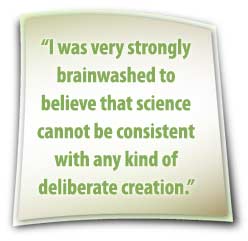 volutionary ideas are generally thought to refer to the origin of living things. However, such ideas have seeped into many aspects of science to include sciences dealing with both living and nonliving things. See Related Story.
volutionary ideas are generally thought to refer to the origin of living things. However, such ideas have seeped into many aspects of science to include sciences dealing with both living and nonliving things. See Related Story.
For example, the study of the formation of the stars, galaxies, and the universe itself employs evolutionary ideas in the sense that many believe that natural, nondeliberate, nondirected changes acting over time can produce all of the features of our universe. Likewise, Darwin famously proposed that the variety of life itself is entirely the result of similar nondeliberate natural processes acting over time.
Darwin published his seminal book, On the Origin of Species by Means of Natural Selection, or the Preservation of Favored Races in the Struggle for Life, in 1859. Until Darwin, evolutionary ideas, though prevalent in the scientific community, had not really taken hold. Most scientists still believed that an intelligent or even a divine force was at work in nature and that this was responsible for certain aspects of living things and of the universe itself.
So why were Darwin’s ideas so fundamentally different and focus-changing? The famous British evolutionary biologist Richard Dawkins put it this way in his 1986 book, The Blind Watchmaker: “Although atheism might have been logically tenable before Darwin, Darwin made it possible to be an intellectually fulfilled atheist.”
In other words, Darwinian ideas, if accepted and expanded a bit, remove the need for God or any other directed intelligent force at work in the entire universe. If taken to its logical conclusion, Darwinian thinking removes the need for any other force beyond the nonintelligent, nondirected, noncaring forces of an all-powerful nature.
 This was an earth-shattering idea when Darwin first presented it. According to William Provine, professor of biological sciences at Cornell University: “Naturalistic evolution has clear consequences that Charles Darwin understood perfectly [namely:]
This was an earth-shattering idea when Darwin first presented it. According to William Provine, professor of biological sciences at Cornell University: “Naturalistic evolution has clear consequences that Charles Darwin understood perfectly [namely:]• No gods worth having exist;
• No life after death exists;
• No ultimate foundation for ethics exists;
• No ultimate meaning in life exists; and
• Human free will is nonexistent.”1
Of course, there are evolutionists who would take exception to the likes of Dawkins and Provine. Some evolutionary scientists even claim the title of Christian—as, for example, evolutionary biologist and famous apologist Kenneth Miller of Brown University (who is a “devout Catholic”). Francis Collins, who first sequenced the human genome, is also an active Christian. Of course, these evolutionary scientists draw a distinct line between science and religion—or between science and faith.
So what’s the difference between science and religion?
For many, religion is based more on feeling, on desire, or on a personal “experience” with a god or godlike “higher power”; science, on the other hand, is empirical, testable, and repeatable by others, and able to generate “predictive value” with use of the “scientific method.”
But what is the value of one’s religion if it has absolutely no basis in any sort of physical, testable, potentially falsifiable reality? How is this sort of religious belief any different from a child’s belief in Santa Claus? Sure, it might be able to provide warm, fuzzy feelings of goodness, but it would be useless when it comes to having a solid hope or assurance that’s anything more than wishful thinking.
Evidence Building
As it turns out, there are a number of prominent scientists who are cautiously—if not openly—questioning the very basic assumptions of naturalism and Darwinian-style evolution. Even when it comes to the nonliving aspects of this universe, a number of famous scientists are starting to see clear, scientific evidence of deliberate manipulation—evidence, in other words, of intelligent design.
For example, Charles Hard Townes, winner of a Nobel Prize for physics and a University of California (Berkeley) professor, makes the following interesting argument: “Intelligent design, as one sees it from a scientific point of view, seems to be quite real. This is a very special universe: it’s remarkable that it came out just this way. If the laws of physics weren’t just the way they are, we couldn’t be here at all. The sun couldn’t be there, the laws of gravity and nuclear laws and magnetic theory, quantum mechanics, and so on have to be just the way they are for us to be here.”2
He goes on: “Some scientists argue that ‘well, there’s an enormous number of universes and each one is a little different. This one just happened to turn out right.’ Well, that’s a postulate, and it’s a pretty fantastic postulate—it assumes there really are an enormous number of universes and that the laws could be different for each of them. The other possibility is that ours was planned, and that’s why it has come out so specially.”3
Eugene Wigner (Nobel Prize in physics) also noted in his widely quoted paper:
“The enormous usefulness of mathematics in the natural sciences is something bordering on the mysterious . . . there is no rational explanation for it. . . . The miracle of the appropriateness of the language of mathematics for the formulation of the laws of physics is a wonderful gift which we neither understand nor deserve.”4
Interesting comments, indeed—for a modern genius with a Nobel Prize in physics!
When it comes to living things, there are also a number of prominent scientists who are beginning to doubt the power of mindless nature alone to explain both the origin and the diversity of living things on this planet. Sir Frederick Hoyle (who first coined the derogative term “big bang theory”) and Chandra Wickramasinghe (well-known mathematician) said:
“No matter how large the environment one considers, life cannot have had a random beginning.” “From the beginning of this book we have emphasized the enormous information content of even the simplest living systems. The information cannot in our view be generated by what are often called ‘natural’ processes, as for instance through meteorological and chemical processes. . . . Information was also needed. We have argued that the requisite information came from an ‘intelligence.’”5
 Wickramasinghe and Hoyle explain as follows:
Wickramasinghe and Hoyle explain as follows:“Once we see . . . that the probability of life originating at random is so utterly minuscule as to make it absurd, it becomes sensible to think that the favorable properties of physics on which life depends are in every respect ‘deliberate’ [or created]. . . . I now find myself driven to this position by logic. There is no other way in which we can understand the precise ordering of the chemicals of life except to invoke the creations on a cosmic scale. . . . We were hoping as scientists that there would be a way round our conclusion, but there isn’t.”6
Wickramasinghe was especially shocked by this conclusion. He notes his bewilderment in the following passage:
“It is quite a shock. From my earliest training as a scientist I was very strongly brainwashed to believe that science cannot be consistent with any kind of deliberate creation. That notion has had to be very painfully shed. I am quite uncomfortable in the situation, the state of mind I now find myself in. But there is no logical way out of it.”7
Mindless Nature Cannot Cut It
So while it is quite clear that apparently mindless natural processes do have certain powers that are often amazing, it is also quite clear that these powers are limited in explanatory importance when it comes to certain features of both living and nonliving things in our universe. When
it comes to living things, in particular, random mutations do work to produce some rather mundane changes over time—as in certain forms of antibiotic resistance, flightless birds on windy islands, cavefish without eyes, sickle cell anemia, and the like.
A little research will show that all known examples of evolution “in action” have never produced a novel protein-based system or function that requires more than a few hundred specifically arranged amino acid building blocks working together at the same time. Yet every living thing has far more complex protein-based systems that require a minimum of thousands of these specifically arranged amino acid building blocks.
For example, the flagellar motility system found in bacteria such as E. coli requires a minimum of more than 10,000 specifically coded amino acids all working together at the same time for minimum useful motility functionality. No such system, or even a subpart of such a system, has been shown to evolve in observable time. And statistically, systems at such high levels of functional complexity could not evolve even in trillions of years.8
Such features of living things give just as much evidence to support a belief in an intelligent designer as any described by forensic scientists or anthropologists. This is why even some Nobel laureates are starting to take another look at intelligent design as a viable scientific theory that should be explored further, rather than be completely discarded at the behest of the popular atheists and blind-faith Christians who are currently prominent in mainstream science today.
God is the author of both nature and the written Word. His signature is clearly evident in both for those who are open to it, even for those mainstream scientists trained without any religious background or motivation. Then should not we who have both the works of nature and the Written Word be all the more in awe of God—His power, majesty, and amazing love for us?
_____________
1William B. Provine, “Evolution: Free Will and Punishment and Meaning in Life,” abstract of Will Provine’s 1998 Darwin Day Keynote Address (bevets.com/equotesp5.htm; last accessed Feb. 12, 2009).
2Bonnie Azab Powell, “‘Explore as Much as We Can’: Nobel Prize Winner Charles Townes on Evolution, Intelligent Design, and the Meaning of Life,” NewsCenter, June 17, 2005 (www.berkeley.edu/news/
media/releases/2005/06/17_townes.shtml; last accessed Feb. 12, 2009).
3Ibid.
4Eugene Wigner, Communications in Pure and Applied Mathematics, vol. 13 (1960): 1-14.
5Sir Fred Hoyle and Chandra Wickramasinghe, Evolution From Space (1981), pp. 148, 150.
6Hoyle and Wickramasinghe, as quoted in “There Must Be a God,” Daily Express, Aug. 14, 1981, and “Hoyle on Evolution,” Nature, Nov. 12, 1981, p. 105.
7Ibid.
8Sean Pitman, “The Evolution of the Flagellum and the Climbing of ‘Mt. Improbable,’” February 2009 online article (www.detectingdesign
.com/flagellum.html; last accessed Feb. 12, 2009).___________________
Sean D. Pitman is a pathologist. He writes from Redding, California.

![]() volutionary ideas are generally thought to refer to the origin of living things. However, such ideas have seeped into many aspects of science to include sciences dealing with both living and nonliving things. See Related Story.
volutionary ideas are generally thought to refer to the origin of living things. However, such ideas have seeped into many aspects of science to include sciences dealing with both living and nonliving things. See Related Story. This was an earth-shattering idea when Darwin first presented it. According to William Provine, professor of biological sciences at Cornell University: “Naturalistic evolution has clear consequences that Charles Darwin understood perfectly [namely:]
This was an earth-shattering idea when Darwin first presented it. According to William Provine, professor of biological sciences at Cornell University: “Naturalistic evolution has clear consequences that Charles Darwin understood perfectly [namely:] Wickramasinghe and Hoyle explain as follows:
Wickramasinghe and Hoyle explain as follows: